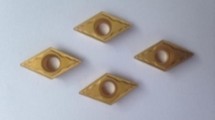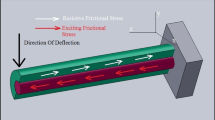Abstract
Regenerative chatter in machining process is a root cause for tool wear and poor surface finish resulting in low production rate. Hence research has to be focused to identify an opportunity to suppress these chatters. This investigation is attempted to reduce the tool wear in boring process by incorporation of shape memory alloy (SMA) mass dampers in boring tool. The copper and Zinc based SMA mass dampers were placed at various position of boring bar and the effect of damper position and machining parameters on the tool wear was studied. Boring process was carried out on grey cast iron pipe by varying the damper position (54, 64 and 74 mm), cutting velocity (25, 50 and 75 m/min) and depth of cut (0.2, 0.4 and 0.6 mm). The prediction model was developed to correlate the relationship between machining parameters and tool wear. The optimum damper position and machining parameters to minimize the tool wear was determined using response surface methodology (RSM). The confirmation test on the optimized value has witnessed efficient prediction of the damper position and machining parameters for reduced tool wear in boring process.













Similar content being viewed by others
References
Tlusty J, Manufacturing and Process Equipment, Prentice Hall, Upper Saddle River; ISBN: 0-201-49865-0 (1999).
Altintas Y, Manufacturing Automation, Cambridge Univ. Press, Cambridge (2000).
Tobias S A, Machine-Tool Vibration, Blackie, London (1965).
Ema S, and Marui E, Int J Mach Tools Manuf 40 (2000) 1141–1156.
Chung D D L, J Mater Sci 36 (2001) 5733–5737.
Atabey F, Lazoglu I, and Altintas Y, Int J Mach Tools Manuf Design Res Appl 43 (2003) 477–484.
Cardi A A, Firpi H A, Bement M T, and Liang S Y, Mech Syst Signal Process 22 (2008) 1481–1494.
Quintana G, and Ciurana J, Int J Mach Tools Manuf 51 (2011) 363–376.
Ramesh K, Alwarsamy T, and Jayabal S, Int J Mater Prod Technol 46 (2013) 47–70.
Natarajan U, Periyanan P R, and Yang S H, Int J Adv Manuf Technol 56 (2011) 177–185.
Ozlu E, and Budak E, Trans ASME, 129 (2007) 726.
Fu Q, Lundin D, and Nicolescu C M, J Mater Eng Perform 23 (2014) 506–517.
Acknowledgments
The authors would like to thank Karunya University, Coimbatore for providing the experimental set up to carry out this investigation. The authors would also like to thank S. Balasubramanain, Omega Inspection and Analytical laboratory, Chennai for his valuable suggestion to carry out this work.
Author information
Authors and Affiliations
Corresponding author
Rights and permissions
About this article
Cite this article
Chockalingam, S., Natarajan, U. & Kalyana Sundaram, S. Modeling and Optimization of Tool Wear in a Passively Damped Boring process using Response Surface Methodology. Trans Indian Inst Met 69, 1443–1448 (2016). https://doi.org/10.1007/s12666-015-0707-5
Received:
Accepted:
Published:
Issue Date:
DOI: https://doi.org/10.1007/s12666-015-0707-5




